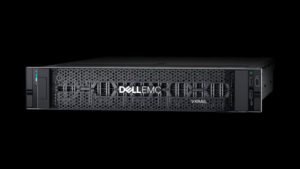Dell EMC is expanding its hyperconverged infrastructure portfolio with new systems built around 14th generation PowerEdge servers.
Converged (CI) and hyperconverged infrastructure (HCI) is a fancy way of saying turnkey systems with compute, storage, networking and software all combined into a single bundle. Rather than building a system from a variety of vendors, the customer gets everything they need from one vendor and it comes pre-configured to run out of the box.
It is basically a page out of the mainframe book, when everything came from one vendor (usually IBM). As server technology moved away from big iron and the x86 market took over, pieces were fragmented. You’ve got your servers from Dell, HP or IBM, storage from EMC or NetApp, networking from Cisco or 3Com, etc.
Consultants and integrators helped with the dirty work of installing everything, but it was still an assembly process. Cisco really got the ball rolling in 2009 when it introduced the Unified Compute Systems that marked its entry into the server market, combining compute, storage and networking along with virtualisation software. Since then, every vendor has offered it.

Dell EMC’s VxRail Appliance_PowerEdge14G 2U (Image: Dell EMC)
CI and HCI is popular with vendors because it means one big sale of all the pieces people need. IT likes it because the systems are ready to go out of the box, having been built and tested and fully integrated by the OEM. The main difference between CI and HCI is HCI has more software services built in, like data deduplication and disaster recovery.
HCI market grows
The result is one of the few bright spots in an otherwise dismal server market. IDC says HCI enjoyed worldwide revenue growth of 48.5% year over year in the second quarter of 2017, and Dell EMC holds the top spot, with 29% of the market. Second is Nutanix with 20% of the market.
Dell EMC’s PowerEdge servers run the latest Intel Xeon processors and include 150 custom requirements for software-defined storage (SDS) built in. Since software-defined everything is the hallmark of HCI, this makes the new PowerEdge ideal for HCI systems
Other new features include improved support for SSDs in scale-out deployments; faster initialisation and streamlined data storage management; increased drive cooling for improved reliability; and, optional, common user interfaces across server and HCI platforms for Dell EMC systems management capabilities.
Dell claims the upgraded servers have up to 1.7 times more processing power than previous generations and up to 62% higher internal bandwidth, which means faster movement of data within the system. It also boasts twice the IOPS and twice the response time as older systems.
Dell EMC is offering two systems: the VxRail Appliance family, running VMware vSAN and jointly developed with VMware, and the XC Series, designed for users seeking a choice of hypervisors, such as Microsoft Hyper-V, or those wishing to run a multi-hypervisor environment. The servers will be available on December 12.
IDG News Service






Subscribers 0
Fans 0
Followers 0
Followers